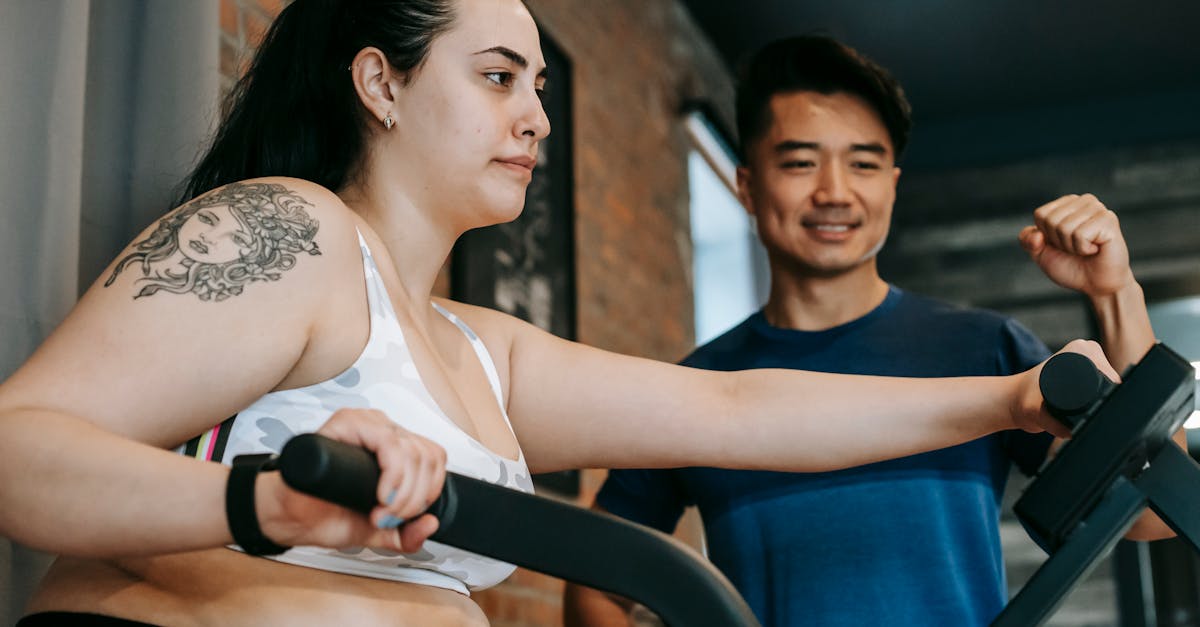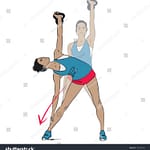Get Fit Quickly by Following the FITT Principle
Are you tired of feeling out of shape and sluggish? Have you been searching for a way to get fit quickly and effectively? Look no further than the FITT principle. With its focus on balance, injury prevention, stamina training, functional movement, core strength, body composition, flexibility and exercise programs tailored to your goals you can achieve a higher level of fitness in less time than you ever thought possible.
In this article we will dive deep into the FITT principle and explore how it can help you transform your body and health. We will provide detailed explanations of each aspect of the principle so that by the end of this article you will have all the tools necessary to create an effective workout plan for yourself. Say goodbye to tedious hours spent at the gym without seeing results – with the FITT principle as your guide, achieving your fitness goals is well within reach.
The FITT Principle: What It Is and Why You Need It
Whether you are a beginner or a seasoned athlete, the FITT principle is the perfect guide to help you achieve your fitness goals. So what exactly is this principle, and why should you follow it? The FITT principle stands for Frequency, Intensity, Time, and Type—the four pillars of an effective exercise program. By tailoring these variables to your specific needs and abilities, you can create a workout routine that delivers results without putting unnecessary strain on your body.
FREQUENCY
The frequency of your workouts refers to how often you exercise during a given week. This variable can be adjusted based on your fitness level and schedule. For beginners, two to three sessions per week may be enough to start seeing improvements in strength and flexibility. As you progress in your training, four to five sessions per week may be necessary to continue challenging yourself.
It’s important not to overdo it when it comes to frequency. Giving yourself enough time for recovery between workouts is essential for avoiding injury and achieving long-term results.
INTENSITY
The intensity of your workouts refers to how hard you push yourself during exercise. This variable can be adjusted by manipulating factors such as weight lifted or running speed. Higher intensity workouts can lead to greater gains in strength and endurance but also require adequate rest periods.
It’s essential not only to challenge yourself but also not push beyond safe limits when it comes to intensity levels during exercise programs . Taking incremental steps up in intensity over time will allow for steady progress without risking injury or burnout.
TIME
The amount of time spent exercising during each session is another component of the FITT principle that can be adjusted based on personal goals and schedule constraints. Beginners may start with shorter sessions of 20-30 minutes, while more experienced individuals may aim for 60 minutes or longer.
It’s important to note that the length of your workout doesn’t always correlate to its effectiveness. Opting for shorter, more intense workouts over longer, less focused ones may lead to better results in a shorter amount of time.
TYPE
The type of exercise you choose is the final variable in the FITT principle. This refers to the specific activities you engage in during your workouts, such as strength training or cardio exercises. Choosing the right type of exercise is crucial for avoiding boredom and keeping your body balanced and challenged.
By utilizing all four components of the FITT principle and tailoring them to your personal needs and goals, you can create an effective workout routine that delivers results without causing injury or burnout.
 Balance Training: Finding Stability in Fitness
Balance Training: Finding Stability in Fitness
Balance training is an essential component of any fitness program. It involves exercises that improve your body’s ability to maintain balance, which helps prevent falls and injuries during activities such as running, jumping, and lifting weights.
When you think of balance training, you may picture standing on one leg or using a wobble board. While these are effective exercises, there are many other ways to improve your balance. For example, yoga poses like tree pose and warrior III challenge your stability while also building strength and flexibility.
Incorporating balance training into your fitness routine can have numerous benefits beyond injury prevention. It can improve posture, enhance coordination, and even boost athletic performance by increasing agility and reaction time.
Injury Prevention: Avoiding Damage While Staying Active
It’s easy to get caught up in the excitement of a new workout routine, but pushing yourself too hard can lead to injuries that will set you back even further. That’s why injury prevention is a crucial part of any fitness plan. By taking steps to protect your body, you can stay active and reach your goals without risking unnecessary damage.
Warm Up Properly
The most effective way to prevent injuries is by warming up properly. A good warm-up should last at least 5-10 minutes and include dynamic stretching exercises that help increase blood flow throughout your body. Start with some light cardio like jogging or jumping jacks, then move on to stretches that target specific muscle groups you’ll be using during your workout.
If you’re planning on doing a high-intensity workout, make sure you take the time to warm up properly. It might seem like an inconvenience at first, but trust us – it’s worth it in the long run!
Gradually Increase Intensity
If you’re new to working out or trying a new type of exercise, don’t try to do too much too soon. Your body needs time to adjust and build up strength before you can push yourself to your limits safely.
A common mistake people make when starting out is increasing their intensity or weight too quickly. This not only increases the risk of injury but also makes it harder for your body to recover between workouts. By gradually increasing your intensity over time, you’ll give yourself the best chance of success while minimizing your risk of injury.
Listen To Your Body
Finally, one of the best things you can do for injury prevention is simply listen to your body. If something feels off or painful, don’t ignore it. Continuing to exercise through pain can make things worse and lead to more serious injuries down the line. Instead, take a break and focus on recovery.
When it comes to staying active and injury-free, prevention is key. By taking the time to warm up properly, gradually increase your intensity, and listen to your body’s signals, you’ll be able to reach your fitness goals safely and effectively.
 Stamina Training: Building Endurance for Long-Term Success
Stamina Training: Building Endurance for Long-Term Success
Stamina training is an essential part of the FITT principle when it comes to achieving long-term success in fitness. This type of training helps improve your aerobic capacity and endurance, allowing you to exercise for longer periods without feeling exhausted. Building endurance will also help you push yourself harder during workouts, leading to greater gains in overall fitness.
To build endurance effectively, it’s essential to have a structured cardio plan that progressively increases in intensity and duration over time. Beginners should start with low-impact activities like brisk walking or light cycling and gradually increase the length and intensity of their sessions. As your stamina improves, you can incorporate more challenging exercises like running or high-intensity interval training.
It’s also crucial to incorporate strength training into your stamina-building routine. Strength exercises will help improve muscular endurance, allowing you to perform physical tasks for longer periods without fatigue. Compound exercises like squats or lunges that engage multiple muscle groups simultaneously can be particularly effective at building endurance while also improving overall strength and mobility.
Functional Training: Making Every Movement Count
Functional training is all about making every movement count. Unlike traditional weightlifting exercises, the goal of functional training is not to isolate individual muscle groups, but to improve overall movement patterns and increase your body’s ability to perform daily activities with ease. Functional exercises can range from bodyweight movements like squats and lunges, to more complex movements like kettlebell swings and medicine ball throws.
The beauty of functional training is that it can be tailored to fit any fitness level or desired outcome. For someone just starting out in their fitness journey, simple bodyweight movements like squats, lunges, and push-ups can help build a strong foundation before moving on to more complex exercises. For those looking for a challenge, movements like burpees or box jumps can provide a full-body workout that increases strength and cardiovascular endurance.
Beyond the physical benefits of functional training, there are also mental benefits. By challenging yourself with new movements and constantly pushing outside of your comfort zone, you’re also building mental toughness and resilience. This mental fortitude can carry over into other areas of your life as well, allowing you to tackle challenges with greater ease.
Core Strength: Building a Strong Foundation
When it comes to building a fit and healthy body, core strength is an essential component. Your core muscles are the foundation of all movement and stability in your body. These muscles help you perform everyday activities, such as lifting groceries, climbing stairs, and bending over to tie your shoes. Having a strong core will also improve your posture, balance, and overall athletic performance.
The Importance of Core Strength Training
Core strength training involves exercising the muscles in your abdominal region, lower back, hips, and pelvis. It’s important to train these muscles regularly because they play a crucial role in supporting your spine and maintaining good posture.
Incorporating core strengthening exercises into your fitness routine can also help reduce back pain caused by weak or imbalanced core muscles. By strengthening these muscles, you’ll take pressure off of your lower back and help prevent injury during physical activity.
Effective Core Strengthening Exercises
There are many different exercises that can be done to strengthen the core muscles. Some popular options include planks, crunches, Russian twists, bicycle kicks, and leg raises.
A great way to challenge yourself is by incorporating stability balls or resistance bands into your workouts. These tools force you to engage more muscle fibers throughout the exercise for increased effectiveness.
Remember to focus on proper form during each exercise – contracting the abdominal region while keeping the spine neutral – for maximum benefit without risking injury or strain on other areas of the body.
 Body Composition: Changing Your Shape from the Inside Out
Body Composition: Changing Your Shape from the Inside Out
If you want to achieve a fit and healthy body, it’s important to focus not only on losing weight but also on changing your body composition. This means reducing your body fat percentage and increasing your lean muscle mass. By doing so, you will become stronger and more toned, with a better overall appearance and improved health.
The Importance of Body Composition
Body composition is a crucial factor in overall health and wellness. Even if two people have the same weight, their body composition can be drastically different. A person with a higher percentage of lean muscle mass will have a higher metabolism rate than someone with more fat tissue, meaning they burn more calories at rest.
Focusing solely on weight loss without addressing body composition can lead to unhealthy habits like crash dieting or over-exercising. These approaches may result in short-term weight loss but can negatively impact overall health in the long run.
Strategies for Changing Body Composition
The most effective way to change your body composition is through strength training exercises that target major muscle groups throughout the body. Compound movements like squats, deadlifts, lunges and bench presses are great for building lean muscle mass.
In addition to strength training, it’s important to maintain a balanced diet that includes plenty of protein and healthy fats while minimizing processed foods and simple carbohydrates.
A combination of strength training exercises, cardiovascular activities like running or cycling, and proper nutrition is key to changing your body composition in a healthy way. By sticking to these strategies consistently over time, you’ll notice significant changes in your physique as well as improvements in overall health and well-being.
Flexibility Training: Staying Limber and Mobile
As we age, our muscles and joints become less flexible, leading to stiffness and discomfort. Flexibility training is essential for maintaining range of motion, preventing injuries, and improving overall quality of life. In this section, we’ll explore the benefits of flexibility training and provide some tips for incorporating it into your fitness routine.
Benefits of Flexibility Training
Improved flexibility can help you perform daily activities with ease and reduce the risk of injury. Stretching exercises can also increase blood flow to muscles, which can help improve your posture and decrease muscle tension. Incorporating regular stretching into your fitness routine can also improve athletic performance by increasing joint mobility.
In addition to physical benefits, flexibility training has also been shown to have mental health benefits. Stretching exercises can help reduce stress and anxiety by promoting relaxation. Some studies have even linked stretching exercises with improved brain function.
Tips for Flexibility Training
The American College of Sports Medicine recommends stretching at least two times per week as part of a balanced exercise program. When stretching, it’s important to warm up first with some light aerobic activity like walking or cycling. This will help increase blood flow to muscles and prepare them for stretching.
You should hold each stretch for 15-30 seconds without bouncing or jerking movements that could cause injury. It’s important not to push yourself too hard when stretching; you should feel a slight discomfort but not pain during the stretch. Finally, it’s important to stretch all major muscle groups including arms, legs, back, chest, shoulders and neck.
Incorporating flexibility training into your fitness routine is an essential component to maintaining range of motion as you age while helping prevent injuries that could sideline you from physical activity entirely.
Exercise Program: Putting It All Together
After understanding the importance of balance, injury prevention, stamina building, functional training, core strength, body composition, and flexibility training in applying the FITT Principle to your workouts, it’s time to put it all together in a cohesive exercise program. Designing an exercise program that fits your fitness goals and personal preferences can be challenging and overwhelming. But by following the FITT principle and incorporating the various components discussed above, you’ll be on your way to achieving success.
Determine Your Goals
The first step in putting together an effective exercise program is determining your fitness goals. Are you looking to build muscle mass or increase endurance? Do you want to lose weight or simply improve overall health? Different goals require different types of training programs. Once you have determined your goals and objective, select specific exercises that help achieve those goals.
For example if you are looking to build muscles mass then focusing on compound exercises like bench press,squats dead-lifts will be more beneficial than exercises that isolate specific muscles like bicep curls. Similarly if endurance is what you are aiming for then high intensity interval training(HIIT) that involves short bursts of intense activity followed by periods of rest will help improve cardiovascular fitness.
Create A Plan And Monitor Progress
Once your goals are established and exercises selected its time to create a detailed plan with realistic targets. Set achievable benchmarks as this helps track progress giving a boost when needed most.When designing a workout plan which includes multiple components ensure balance between activities so that muscle groups aren’t overworked or neglected. Also include modifications for variety so workouts remain fresh.
Finally stay consistent with the plan but make necessary adjustments based on progress made over time. It’s also important not to compare yourself with others rather focus on reaching your own goals. With patience and determination, you’ll not only enjoy the physical benefits of a well-rounded exercise program that leverages the FITT principle but also gain confidence and a sense of accomplishment that can carry over into other areas of your life.
Conclusion
In conclusion, the FITT principle is a highly effective approach to getting fit quickly and achieving long-term success. By utilizing balance, injury prevention, stamina training, functional training, core strength building, body composition changes, and flexibility training in your exercise program, you can create a holistic approach to fitness that will transform your body from the inside out. Remember to start slow and build up gradually as you become more comfortable with each phase of your fitness journey. With hard work and dedication to the FITT principle, you can achieve a healthy and fit lifestyle that will serve you well for years to come.















